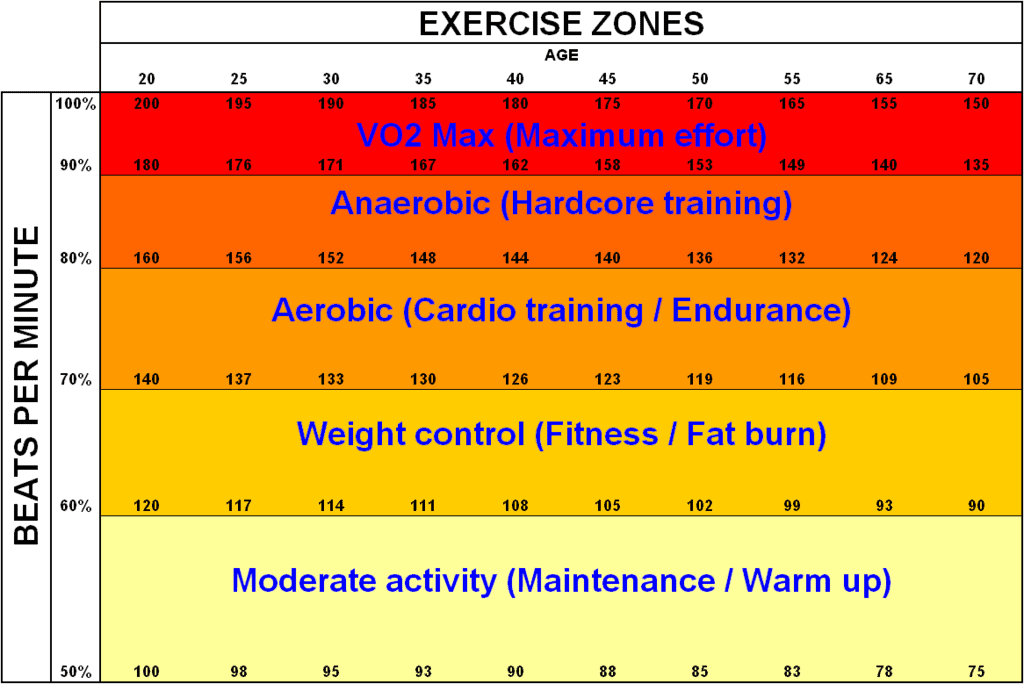 One of my goals as a personal trainer and health coach is to help people get motivated to improve their health. Because getting motivated is often the most difficult part, you need to use as many strategies as possible to help yourself. One way is by understanding target heart rate zones so you can work out more effectively. And to do this, you need a heart rate monitor.
One of my goals as a personal trainer and health coach is to help people get motivated to improve their health. Because getting motivated is often the most difficult part, you need to use as many strategies as possible to help yourself. One way is by understanding target heart rate zones so you can work out more effectively. And to do this, you need a heart rate monitor.
Without using a heart rate monitor during workouts, you’ll still be able to notice things like weight loss and improvements in strength. After a while, you’ll also be able to see the difference in how your body looks and feels. But those improvements take longer than you think to show up which can be frustrating and discouraging.
A heart rate monitor makes workouts more interesting by showing you exactly how hard you’re working right from the start. Some days I feel like I’m working really hard but my monitor tells me differently! Other days my workout feels easy but my heart rate is much higher than it seems. This has taught me that I can’t trust how I feel as a predictor of how hard I’m working. Some days just take more effort than others.
If you know your fitness level when you start an exercise program, then you can use that information right away to challenge yourself more. You do that by tracking your heart rate and working out in certain target heart rate zones. These zones will help you to achieve different goals and small improvements will be noticeable much sooner.
This really isn’t as confusing as it might sound. So let me explain it all in a little more detail.
Start by estimating your maximum heart rate
Before doing anything else you need to figure your age-predicted maximum heart rate (maxHR). If you have a heart rate monitor it might figure that for you. But it’s very easy to calculate on your own using one of several different formulas. Here are two of the most popular and easiest.
-
- 207 – (0.7 x age). Start with what’s in parenthesis, then subtract that!
- 220 – age
You’ll notice if you calculate both of these they’ll give you slightly different numbers. Don’t worry about that. This is just an estimate or a guide to help you gauge your own personal progress. Unless you’re competing in endurance races an estimate works fine for most exercise programs.
The only way to know your real maximum HR is to go through some very difficult (maximal) cardio testing to see how high you can get your heart rate during exercise. We did this in my Exercise Science program and it wasn’t fun! The other way is to do submaximal testing in a lab setting and then your max HR is estimated from that. Not nearly as hard and worth the effort if you’re serious.
Then figure your target heart rate zones
Once you’ve figured your maxHR then you know how hard you need to work out in order to achieve certain goals. That’s where target heart rate zones come into play. A target heart rate zone is the range of beats per minute (bpm) that describes a certain level of effort.
So if you’re a 65-year-old woman, your estimated maxHR is about 162 bpm according to the first formula. Don’t expect to ever work out at 162 bpm! Only elite athletes ever do that, no one else would want to! From there you can calculate your target heart rate zones by multiplying 0.5 (for 50%), 0.6, 0.7, 0.8, and 0.9 by 162. Each of these percentages is represented in this chart.

You could also just use the ages specified in the chart and their bpm to figure out what zone you’re working in. But they only go up to 70 so that’s a slight limitation.
What do the heart rate zones mean?
What this chart shows is that if you’re working out at 50-60% of your maxHR then you’re just getting warmed up. If you’re at 60-70% of your max then you’re in “weight control” or “fat burn” mode which is perfect! If you get up into 70-80% of your maxHR then you’re training your heart for better endurance. This zone and the ones above push you to improve your aerobic fitness.
Each zone has a purpose. Just notice when you start working out what zone you’re most comfortable in. Then over time, the exercise will get easier and you can start to push yourself to work out longer. Then you can increase your intensity by pushing yourself into higher heart rate zones, which means more effort is being used.
You want to keep pushing yourself to do more because aerobic fitness is not only associated with better mental health, it’s also associated with longer life! Plus, the longer and harder you work out the more calories, and therefore fat, you’ll burn. I would love to think everyone is working out for long-term health but isn’t it really more about burning off excess fat?!
Related article: Can you lose weight with exercise alone?
How to work out for the best results
The ACSM recommends that we work out aerobically for 30 minutes at least 5 days a week at a moderate level. That means in the range of about 50-70% of your target heart rate zone. The workouts can be divided into 10-15 minute sessions throughout the day. So when you’re first starting, do what you can and work up to 30 minutes at a time over a period of months.
Most people hate long cardio workouts because it’s very uncomfortable to get your heart rate up and keep it up for an extended period of time. That’s why people like to just walk for exercise! But I’m here to tell you that it does get easier with training! Your starting efforts are NOT a predictor of how hard it will always be. So stick with it and keep pushing yourself to do more.
When I first got my elliptical machine I thought I was going to die within 5 minutes on it! So I stayed at 5 min for a while then each month I pushed myself to do a little more until I finally got up to 30 minutes at a time. There are still days that I don’t work out as intensely but most often I like to push myself into my 85-90% target heart rate zone.
If you do moderate-intensity exercise forever, you’ll eventually reach a plateau. This is especially frustrating for weight loss efforts. If you’ve already lost all the weight you want and just want to maintain it then it’s ok to stay at that level. But if you want to continue to improve and lose more weight then you need to do something different. HIIT workouts are a great way to progress in fitness.
Move on to HIIT training for better results
HIIT stands for high-intensity interval training. It means that during your cardio workout you start at a moderate level of intensity (MI) then for short “intervals” you do higher intensity (HI) work. Those intervals could be as little as 30 seconds at a time or up to 5 minutes or more. HI means you’re in the 70-90% target heart rate zone.
You always want to “rest” after the HI work by going back to some MI work for a period of time. If you’re new to HIIT workouts, you want your rest periods to be longer than your HI work. For example, do HI for 30 seconds and do MI (rest) for 1-2 minutes. Over time you can work up to resting for the same amount of time as the HI work (30 sec/30 sec). The following article explains how to do HIIT while walking.
Related article: Walking for weight loss.
When you do HIIT workouts you don’t have to exercise for as long. This is because your workouts are more intense overall and therefore you burn more calories. In addition, because the work is harder you’re building more muscle while you work out. That helps more in the long run because the more muscle you have the more calories you burn all the time.
If you’re a beginner to exercise then I suggest just working on moderate cardio for the amount of time you’re able to. Then work on increasing duration before working on increasing intensity. And don’t forget to do a strength training program to build more muscle faster!
Related article: 5 Benefits of strength training for women.
My final thoughts
I’m a competitive person, at least with myself, so I like to push myself to work out at higher intensities. Having a heart rate monitor and knowing my target heart rate zones helps me do that and makes my workouts more interesting. It tells me exactly how hard I’m working each time I work out rather than me assuming I know by how it feels.
Knowing what zone I’m working out in helps me to make sure I’m not slacking off! I don’t want to see my efforts decreasing over the years so it keeps me on track. My goal is to be the 80-year-old woman that’s still fully involved in life and traveling the world! I’ll need strength and stamina to be able to do that.
Related article: The woman I want to be.
If you’re a beginner exerciser then knowing your target heart rate zones will give you a better idea of how much it takes to achieve your health goals. I think it’s an invaluable tool that will help motivate you by giving you more detailed information about your workouts.
Once you get used to a heart rate monitor and understand your own target heart rate zones you won’t want to exercise without that information!

